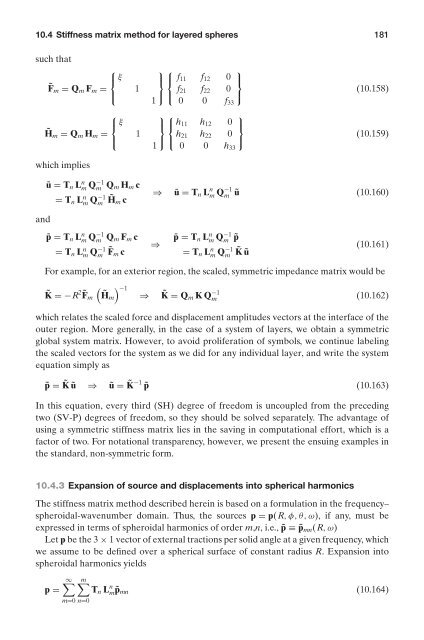Eduardo Kausel-Fundamental solutions in elastodynamics_ a compendium-Cambridge University Press (2006)
You also want an ePaper? Increase the reach of your titles
YUMPU automatically turns print PDFs into web optimized ePapers that Google loves.
10.4 Stiffness matrix method for layered spheres 181<br />
such that<br />
⎧<br />
⎨ ξ<br />
˜F m = Q m F m =<br />
⎩<br />
⎧<br />
⎨ ξ<br />
˜H m = Q m H m =<br />
⎩<br />
1<br />
1<br />
⎫ ⎧<br />
⎫<br />
⎬ ⎨ f 11 f 12 0 ⎬<br />
f<br />
⎭ ⎩ 21 f 22 0<br />
⎭<br />
1 0 0 f 33<br />
⎫ ⎧<br />
⎫<br />
⎬ ⎨ h 11 h 12 0 ⎬<br />
h<br />
⎭ ⎩ 21 h 22 0<br />
⎭<br />
1 0 0 h 33<br />
(10.158)<br />
(10.159)<br />
which implies<br />
ū = T n L n m Q−1 m Q m H m c<br />
= T n L n m Q−1 ˜H m m c<br />
and<br />
¯p = T n L n m Q−1 m Q m F m c<br />
= T n L n m Q−1 ˜F m m c<br />
⇒<br />
⇒<br />
ū = T n L n m Q−1 m ũ (10.160)<br />
¯p = T n L n m Q−1 m ˜p<br />
= T n L n m Q−1 ˜K m ũ<br />
(10.161)<br />
For example, for an exterior region, the scaled, symmetric impedance matrix would be<br />
˜K =−R 2 ˜F m<br />
(<br />
˜H m<br />
) −1<br />
⇒ ˜K = Q m KQ −1<br />
m (10.162)<br />
which relates the scaled force and displacement amplitudes vectors at the <strong>in</strong>terface of the<br />
outer region. More generally, <strong>in</strong> the case of a system of layers, we obta<strong>in</strong> a symmetric<br />
global system matrix. However, to avoid proliferation of symbols, we cont<strong>in</strong>ue label<strong>in</strong>g<br />
the scaled vectors for the system as we did for any <strong>in</strong>dividual layer, and write the system<br />
equation simply as<br />
˜p = ˜K ũ ⇒ ũ = ˜K −1 ˜p (10.163)<br />
In this equation, every third (SH) degree of freedom is uncoupled from the preced<strong>in</strong>g<br />
two (SV-P) degrees of freedom, so they should be solved separately. The advantage of<br />
us<strong>in</strong>g a symmetric stiffness matrix lies <strong>in</strong> the sav<strong>in</strong>g <strong>in</strong> computational effort, which is a<br />
factor of two. For notational transparency, however, we present the ensu<strong>in</strong>g examples <strong>in</strong><br />
the standard, non-symmetric form.<br />
10.4.3 Expansion of source and displacements <strong>in</strong>to spherical harmonics<br />
The stiffness matrix method described here<strong>in</strong> is based on a formulation <strong>in</strong> the frequency–<br />
spheroidal-wavenumber doma<strong>in</strong>. Thus, the sources p = p(R,φ,θ,ω), if any, must be<br />
expressed <strong>in</strong> terms of spheroidal harmonics of order m,n, i.e., ˜p ≡ ˜p mn (R,ω)<br />
Let p be the 3 × 1 vector of external tractions per solid angle at a given frequency, which<br />
we assume to be def<strong>in</strong>ed over a spherical surface of constant radius R. Expansion <strong>in</strong>to<br />
spheroidal harmonics yields<br />
∞∑ m∑<br />
p = T n L n m ˜p mn (10.164)<br />
m=0 n=0



